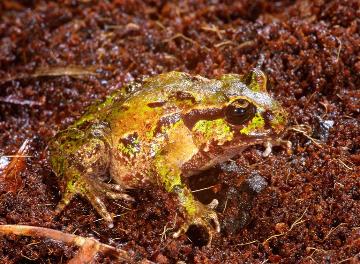


|
Leiopelmatidae:
One of the more primitive of the living frog families. It shares many features generally thought to be inherited from distant ancestors with the Tailed Frogs (Family Ascaphidae). These are small frogs with round pupils, broad heads, and smooth skin on the “soles” of their feet. This family is composed of 4 species belonging to the genus Leiopelma, which is endemic to New Zealand. Many fossils are known, extending its range to surrounding islands, of which the largest was Leiopelma waitomoensis† which reached 100mm SVL compared to extant species which reach a maximum of 50 mm SVL. Adults guard their clutches of direct developing eggs. Young of L. hamiltoni,, and L. archeyi climb onto the backs of parents and complete their development there. Leiopelmids are nocturnal and catch their prey by lunging at it, as they do not have protrusible tongues (like most frogs). They also use alternating kicks when swimming (unlike most frogs). This family does not vocalize, but frogs are known to squeak when molested. These frogs possess: 1) inscriptional ribs (cartilage embedded within abdominal muscle); 2) 9 presacral vertebrae (as in Ascaphidae); 3) retention of caudalipuboischiotibialis muscles (as in Ascaphidae). Despite many shared primitive characters with Ascaphidae, they are considered to be two distinct lineages and may not be each others’ closest relatives.
Genus : Leiopelma (4 species) |
